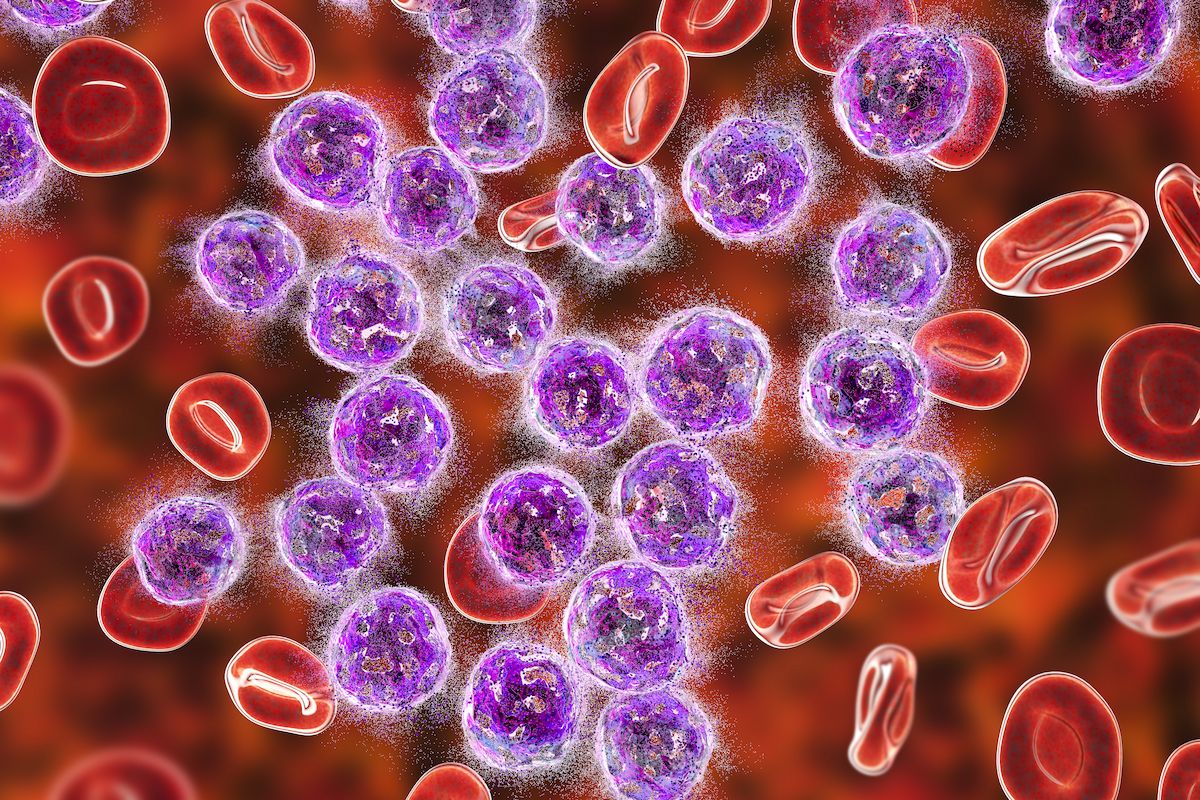MRD Status After Chemotherapy Can Identify NPM1-Mutated AML
Patients with NPM1-mutated acute monocytic leukemia who are minimal residual disease negative do not appear to benefit from allogeneic stem cell transplant after chemotherapy induction, even with a FLT3 ITD co-mutation.
Based on this analysis, the investigators concluded that MRD after induction chemotherapy identifies patients with NPM1-mutated AML who benefit from ASCT in first remission. Further, after second induction, patients who were MRD-negative show no benefit from transplant, even with FLT3 ITD co-mutation.

Molecular minimal residual disease (MRD) after induction chemotherapy can identify patients with NPM1-mutated acute monocytic leukemia (AML) and determine who benefits from allogeneic stem cell transplant (ASCT) in first remission, according to data presented during the 2023 American Society of Hematology (ASH) Annual Meeting and Exposition.
This can stratify decision-making at post remission, namely in patients with FLT3 internal tandem duplication (ITD). At first remission, the role of allogeneic stem cell transplant (ASCT) in NPM1-mutated AML remains controversial as there is significant variation in practice.
Historically, the benefit of ASCT was observed in patients with NPM1-mutated AML in the presence of FLT3 ITD; however, with the increased understanding of MRD and its improvement on survival, the need to identify the primary determinant of benefit has grown. Although ASCT can benefit patients with AML, research suggests that patients with favorable risk generally do better with chemotherapy and that the risks and adverse events from ASCT outweigh the benefits in these patients. Alternatively, in patients who are at adverse risk with AML generally do poorly with chemotherapy and are likely to benefit from transplant.
“In general, an allogeneic transplant is offered in first remission to patients with AML who have an adverse risk. It is not offered in favorable risk,” lead author Jad Othman, MBBS, of Guy’s and St Thomas’ NHS Foundation Trust in London, said in a presentation of the data. “The question of [offering transplant] in intermediate risk has always been one that has been controversial.”
To determine if patients who were MRD-positive had improved survival when they received an ASCT compared with patients who were MRD-negative, data were compared from 2 large United Kingdom studies, AML17 (ISRCTN55675535) and AML19 (ISRCTN78449203).2,3 A total of 737 patients who achieved complete remission and had a valid MRD result were evaluated. In AML17, 17% of patients were MRD-positive and 21% in AML19 were MRD-positive. Overall, ASCT was performed in 20% of patients in AML17 and 25% of patients in AML19.
“Importantly, the selection of patients for transplant in the 2 studies were very different,” Othman said. “In AML17, patients were selected based on a validated risk score, as determined by age, sex, secondary disease, cytogenetics, white cell count, and response after 1 course of chemotherapy.” In AML19, patients underwent ASCT only if they were MRD-positive in the peripheral blood post chemotherapy cycle 2.
Time-to-event variables were analyzed using the Kaplan-Meier method, and the impact of ASCT was assessed using Cox regression and visualized with Simon-Makuch plots, said Othman.
It had been previously reported in AML17 that patients who were MRD-positive had poor outcomes with a 3-year cumulative incidence of relapse (CIR) rate of 84% and a 3-year overall survival (OS) rate of 25%.4 In AML19, the 3-year CIR was 50% and 3-year OS rate of 51%.
A significant survival advantage (HR, 0.39; 95% CI, 0.24-0.64) was observed in patients who had detectable MRD after the first 2 courses of chemotherapy if they received a transplant in their first remission compared with patients who were MRD-negative (HR, 0.82; 95% CI, 0.50-1.33) after chemotherapy. “Those patients who were MRD-negative after chemotherapy did not derive any survival advantage from having a transplant in their first remission,” Othman said.
MRD also predicts ASCT benefit in patients with NPM1-mutated AML and FLT3 ITD, which has traditionally been considered to be a strong indication for transplant, Othman said. In this patient population, patients who were MRD-positive benefited from ASCT vs no ASCT (HR, 0.52; 95% CI, 0.29-0.93) compared with patients who were MRD-negative (HR, 0.80; 95% CI, 0.37-1.72). “This held true even if it was limited to those patients with a high allelic ratio for FLT3 ITD,” Othman said. In other subgroups, the investigators “weren’t able to identify any MRD-negative population in whom a transplant and chemotherapy provided a survival advantage,” Othman added.
Based on this analysis, the investigators concluded that MRD after induction chemotherapy identifies patients with NPM1-mutated AML who benefit from ASCT in first remission. Further, after second induction, patients who were MRD-negative show no benefit from transplant, even with FLT3 ITD co-mutation.
References
- Othman J, Potter N, Ivey A, et al. The benefit of allogeneic transplant in 1st complete remission in NPM1-mutated AML with or without FLT3 ITD is restricted to those testing MRD positive after induction—an analysis of the UK NCRI AML17 and AML19 studies. Blood. 2023;142 (suppl 1): 425. https://doi.org/10.1182/blood-2023-179033
- Burnett AK, Russell NH, Hills RK, et al. A randomized comparison of daunorubicin 90 mg/m2 vs 60 mg/m2 in AML induction: results from the UK NCRI AML17 trial in 1206 patients. Blood. 2015;125(25):3878-3885. doi:10.1182/blood-2015-01-623447
- Othman J, Wilhelm-Benartzi C, Dillon R, et al. A randomized comparison of CPX-351 and FLAG-Ida in adverse karyotype AML and high-risk MDS: the UK NCRI AML19 trial. Blood Adv. 2023;7 (16):4539–4549. doi:10.1182/bloodadvances.2023010276
- Ivey A, Hills RK, Simpson MA, et al. Assessment of minimal residual disease in standard-risk AML. N Engl J Med. 2016;374(5):422-433. doi:10.1056/NEJMoa1507471
Newsletter
Stay up to date on recent advances in the multidisciplinary approach to cancer.